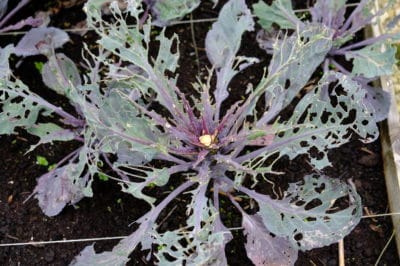Identifying Cabbage Maggots
The cabbage maggot fly resembles a housefly, but it’s only about 1/4 inch long. It is gray with black legs, smoky gray wings, short bristles all over its body, and three black stripes on the back of its mid-section, the thorax, with one additional black stripe on its abdomen. The first generation of the flies each season overwinter as pupae in the ground.
The pupae cases are brown and egg-shaped. You will find them buried from 1 to 5 inches below the soil’s surface, but these pupae cases are very similar to those of other insects, making certain identification difficult.
The flies appear in the early spring, and they are attracted to moisture and rotting vegetation. They fly low to the ground and deposit their eggs in crevices in the soil or at the base of the plants they find emerging in the cool weather.
The eggs are finely ridged, white, oblong in shape, and about 1/8 inch long. Look for them at the base of your cabbage stalks near the soil line or in the soil near your cabbage stalks.
The cabbage maggot is legless and white. It measures about 1/4 to 1/3 inch long, and it is pointed at the head and blunt at the rear.
Identifying Cabbage Damaged by Cabbage Maggots
Young cabbages planted in the spring or fall, when the weather is cooler and damper, are most at risk.
Cabbage maggots eat smaller roots from the plant and riddle larger roots with a network of bored out tunnels. These tunnels disrupt the plant’s ability to draw water and nutrients from the soil, so, above ground you will notice that infested cabbages are prone to wilt. Their growth will be stunted and they will look purplish or blue-gray rather than green. That off-color look, though, is a general symptom of lack of adequate nutrition. It is not a definite sign of a maggot infestation.
To be certain whether or not your cabbages are infested with cabbage maggots, you will need to examine the roots. Roots that have been attacked by cabbage maggots will have slimy, winding, brown tunnels eaten into them and brownish grooves eaten into the surface. You will likely find maggots still on and in the roots.
Controlling and Eliminating Cabbage Maggots
Once you have noticed the symptoms of an infestation above ground, it is probably too late to stop the maggots. If you don’t find too many maggots when you examine the roots, you can try swishing the roots around in a bucket or tub of cold water to remove the maggots and then replanting the cabbage while the maggots drown in the water. You could be putting healthy plants at risk, though.
The best and most certain measures to take are steps aimed at preventing an infestation from occurring. Actions you can take include:
- Clearing your growing space of vegetation at the end of the growing season and adding it to your compost.
- Tilling your growing space in the fall to expose eggs and pupae to winter’s cold.
- Tilling your growing space four to six weeks before planting in the spring if possible.
- Delaying planting for about two weeks, if possible.
- Rotating the crops you plant to different areas of your growing space every one to three years.
- Using cabbage collars around the stalks of your cabbages and grow them under row covers that have the edges buried in the soil.
Companion Plants and Natural Predators
Since cabbage maggots are looking for food, planting an inexpensive root crop, like radishes, near your cabbage may lure the maggots away from the cabbage roots.
Parasitic wasps and nematodes prey on cabbage maggots, as do some subterranean beetles. Cabbage maggots are also vulnerable to some funguses found naturally in the soil.
